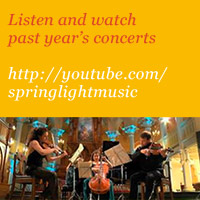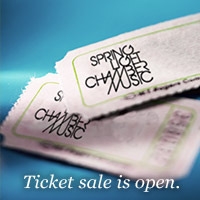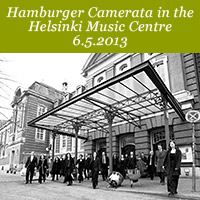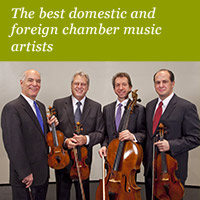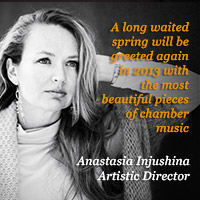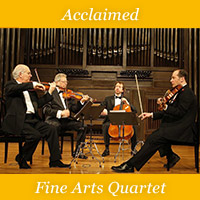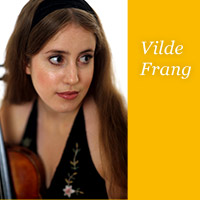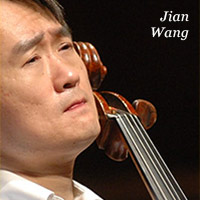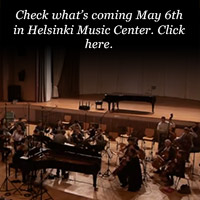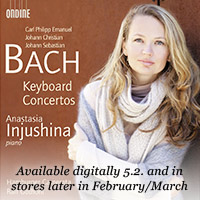MUSICAL PIECES
Please click musical pieces to revel description.
Tuesday 23th April 7 pm Temppeliaukio Church, Helsinki
Joseph Haydn
String Quartet in F Major, Op. 74/2, Hob III:73
Into his suitcase for his second visit to London, in 1794, Joseph Haydn (1732–1809) packed
six new string quartets. In his hands the string quartet developed into the absolute epitome of
Classicism in music, a genre designed primarily for amateur chamber musicians and of a clarity
and intimacy that made it a new kind of art aimed not only at court circles.
Haydn's new style is clearly manifest in his F Major Quartet, Op. 74/2: its form is built of
bigger blocks, the tempo markings are more extreme, the orchestral effects and the virtuoso first
violin speak of an idiom that gave Viennese Classicism a down-to-earth freshness and humanism.
Ludwig van Beethoven
Sonata for Piano and Violin in F Major, Op. 24, "Spring"
The Sonata in F Major, Op. 24 of 1804 by Ludwig van Beethoven (1770-1827) was like a
herald of spring for the Violin Sonata as a genre. In it Beethoven put behind him the formal
social conventions of the 18th century but carried some of the social aspect of the duo sonata –
a musical love affair – over into Romantic parlance.
The "Spring" boldly dramatises the roles of the violin and piano with disregard for the
old rules of propriety. It was assisted in this by Beethoven's keen observance of the instruments'
new developments: the Tourte bow, the higher bridge and other such innovations permitted a louder
tone, greater scope for personal expression and larger-than-natural sentiments.
Ludwig van Beethoven
String Quartet in C Major, Op. 59/3, "Razumovsky"
Count Andrey Kirillovich Razumovsky, a man of Cossack lineage and son of the last hetman of
Ukraine, was the Tsar's diplomatic representative in Austria from 1792. On the Landstraβe
in Vienna he built himself a palace he packed with art treasures that became one of the hotspots
of that city's cultural and social life.
In 1805 Razumovsky commissioned Ludwig van Beethoven (1770-1827) to compose six string
quartets. He received only three, however – but all the greater ones for that. At his request,
Beethoven seasoned his String Quartets, Op. 59 with themes selected from a collection of
Russian folk music supplied by the Count. No authentic Russian tunes have been identified in
the C Major Quartet, but the melody in the second movement does imitate Ukrainian ballads and
the fugue theme of the finale also has a cheerful, Slavic touch.
Thursday 25th April 7 pm Temppeliaukio Church, Helsinki
Wolfgang Amadeus Mozart
Sonata for Two Pianos in D Major, KV 448
Wolfgang Amadeus Mozart (1756–1791) designed his early sonatas for two pianos, four hands for him and his big sister Nannerl to play together and to show off their dazzling Wunderkind virtuosity. The two are captured in a well-known painting showing brother and sister seated at the same keyboard, performing difficult crossed-hand passages under the watchful eye of father Leopold. The challenge is slightly different with two pianos, and the Sonata in D Major for Two Pianos, KV 448, performed with Josepha Auernhammer in November 1781 represents the crowning glory of Mozart’s compositions for two pianos in its panache and its irresistible drive.
Edvard Grieg
Sonata for Cello and Piano in A Minor, Op. 36
Edvard Grieg (1843–1907) usually gave the traditional musical forms a wide birth, seeking to
express himself in lyrical images and with rhapsodic freedom. The Cello Sonata of 1883 was
commissioned by the Leipzig music publisher Peters, but Grieg found more personal motivation
by dedicating it to his cellist brother John. The premiere performance was given by John’s
teacher, the famous cellist and composer Julius Klengel, with Edvard at the keyboard.
Along with the Piano Concerto and the third Violin Sonata, the Cello Sonata is one of Grieg’s
most full-blooded works. Yet instead of classical balance, Grieg aimed at seething emotional
expression – passions reflected in both extremes of tempo and radiant, singing themes and folk
song motifs.
Johannes Brahms
String Quintet No. 2 in G Major, Op. 111
A visit to Italy has had a stimulating effect on many a composer. Johannes Brahms (1833–
1897) was no exception when, on returning home in 1890, he set to work on his second String
Quintet, Op. 111. In the finale, particularly, he let himself be carried away in cheerful
Hungarian
mood.
His contemporaries failed to recognise the Mediterranean open-mindedness and extroversion
of the melodic work, and one of Brahms’s champions, Eduard Hanslick, even detected signs of
introspection. “Brahms appears increasingly to withdraw into himself, seems more at ease, with
ever-greater assurance in the vigorous expression of simple feelings. This work is endowed with
intense emotional life, without effort, without excess, without artifice!”
Friday 26th April 7 pm Temppeliaukio Church, Helsinki
Leoš Janáček
Violin Sonata
The Violin Sonata by Leoš Janáček (1854–1928) was originally inspired by the First World
War that would, he hoped, bring freedom for the Slav peoples suffering under Austrian rule. As
to some extent it did. During the long composition process (1914–1921) the Sonata nevertheless
expanded and acquired a different character.
Written into the finale are messages Janáček wished to send to the Russian forces marching in
to liberate his native Slovakia. The violin motif that recurs throughout the work also raises some
doubts. The Sonata’s many stimuli ultimately merge in a musical stream of consciousness pulled
along by a compelling thirst for life.
Antonín Dvořák
Piano Trio No. 4 in E Minor, Op. 90, “Dumky”
The Czech composer Antonín Dvořák (1841–1904) is strongly associated with Central European
Romanticism, but he, too, had a tendency towards Slav sentiment, manifest in both his melodies
and his structures. The Piano Trio in E Minor, Op. 90, known as “Dumky”, borrows its unusual
structure from the ballad-like “dumka” (meaning “thought” or “reflection”) of Ukraine.
The characteristic features of “dumking” are sudden mood shifts, the alternation of melancholy,
yearning and exuberance. Dvořák religiously applies this principle in the six movements of
his trio: each is clearly divided into slow, strongly sentimental and quick, cheerful, dance-like
sections.
Max Bruch
String Quintet in A Minor, Op. posth.
The course of music was to change many times during the long life of Max Bruch (1838–1920).
Not for Bruch, however: throughout his career he remained faithful to the Romantic style he had
adopted as a young man. He is best known for his first Violin Concerto, composed in 1868, but
its success also became a burden for him.
By the early 1900s Bruch already stood for the past, but in 1918 he wrote his String Quintet in
A Minor. The parts for this were then lost for decades until in 1988 a copy made by Bruch’s
daughter-in-law was discovered in the BBC Library. The warmly Romantic Quintet based on
this was published in 1991.
Sunday 28th April 7 pm Temppeliaukio Church, Helsinki
Wolfgang Amadeus Mozart
Duo for Violin and Viola in G Major, KV 423
Wolfgang Amadeus Mozart (1756–1791) was still a young man employed in his home town,
Salzburg, when he composed his two Duos for Violin and Viola. His patron, Archbishop
Colloredo, had heard the six Duos for this combination of instruments by Joseph Haydn and
immediately ordered six in the same style from his court organist, Michael “brother-of-Joseph”
Haydn.
But Michael Haydn, addicted as he was to the bottle, fell ill while working on the commission
and turned to Mozart. Known for his speedy pen, Mozart was only too pleased to connive in
deceiving his employer and wrote the missing two Duos (KV 423 & 424). Though they were
performed under Haydn’s name, the composer-organist was a decent man and recorded the
identity of the pieces’ true composer for posterity.
Dmitri Shostakovich
Prelude and Scherzo for Double String Quartet, Op. 11
Dmitri Shostakovich (1906–1975) composed his Prelude and Scherzo for Double String Quartet, Op. 11 in 1924–1925, i.e. at around the same time as the First Symphony that marked his breakthrough. Both are astonishingly mature for a composer of under 20, but very different in character. The Shostakovich of Op. 11 is just as sharp, sarcastic, demonic and bitter as the composer of his late works. The chorale-like austerity of the Prelude is offset by a devilish, nightmarish Scherzo dance.
Johannes Brahms
Piano Quartet No. 3 in C Minor, Op. 60
“On the cover you can put a picture of a head with a pistol pointing at it. It will give an idea of
the music. I will send you a suitable photograph,” wrote Johannes Brahms (1833–1897) to his
publisher, Simrock, in 1875 on completing his new Piano Quartet. Yet the Romantic idiom bears
no traces at all of self-destruction.
Brahms had despaired of his Piano Quartet No. 3 in C Minor, Op. 60 from the very beginning.
Clara Schumann, on being shown the first sketches in 1854, had admired the slow movement
as being both magnificent and profoundly moving. Brahms then left the work to mature for
over two decades and in the meantime, in 1862, composed two other radiantly Romantic Piano
Quartets, Opp. 25 and 26.
Monday 6th May 7 pm Helsinki Music Center
Alfred Schnittke
Moz-Art à la Haydn two violins and strings
Moz-Art à la Haydn (1976) by Alfred Schnittke (1934–1998) is in the nature of a collage
in which the composer engages in dialogue with Mozart and Haydn by borrowing snatches of
their works. This recycling of historical fragments nevertheless has a gloomy side that becomes
more pronounced as the work progresses. It maybe demonstrates the impossibility of capturing
anything but mere snippets of Mozart's inspiration swimming homelessly hither and thither in
dissonant space.
Schnittke transcribed Moz-Art for many different line-ups, all deconstructing classic beauty via
modern despair: running Mozart's music through the shredder of history and then trying to stick
it together again.
Carl Philipp Emanuel Bach
Keyboard Concerto in D major, Wq. 43/2
Carl Philipp Emanuel Bach (1714–1788), fifth son of Johann Sebastian, served for many years as harpsichordist to Frederick the Great, King of Prussia, but experienced a sense of liberation – musical included – on leaving conservative Berlin for Hamburg, a city awash with new trends, in 1768. It was there that, in 1771, he penned his six harpsichord concertos Wq 43. The Harpsichord Concerto in D major (Wq 43:2) is possibly the showiest in the set, and at times surprising and sentimental.
Johann Sebastian Bach
Keyboard Concerto in E major, BWV 1053
Johann Sebastian Bach (1685–1750) composed his concertos for 1–4 harpsichords in the late 1720s and the 1730s, mainly for the Leipzig Collegium Musicum. The Harpsichord Concerto in E Major BWV 1053 probably started life as a wind concerto composed during his stay in Cöthen or his early Leipzig years, but he also used its music in cantatas 169 and 49, where the organ provides an obligato. Bach transcribed the material for harpsichord in Leipzig in 1738.
Joseph Haydn
Symphony in G minor, Hob. 1:83 'The Hen'
In 1785 the Concert de la Logue Olympique, the most renowned concert agency in all Paris,
commissioned Joseph Haydn (1732–1809) to write six symphonies. For this it paid him the
princely sum of 25 louis d'or per symphony, and a further five for publication rights. Though
Haydn had, until then, spent his whole life in a remote corner of southern Austria, his reputation
had already spread far and wide in Europe.
Symphony No. 83 in G Minor (The Hen) is so called because of the "pecking" oboe ostinato
in the subsidiary theme of the first movement. The epithet, which became entrenched in the 19th
century, may not do justice to the work as a whole, but it does prove that his contemporaries kept
a close watch on Haydn's music and were always on the lookout for hidden surprises and quirks.
Teoesittelyt: Antti Häyrynen
Translation Susan Sinisalo



